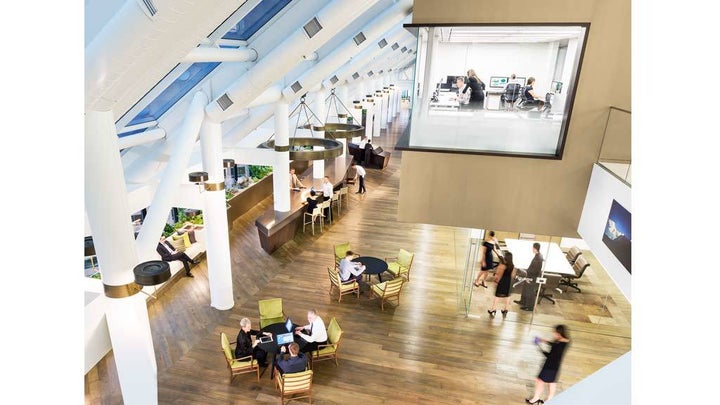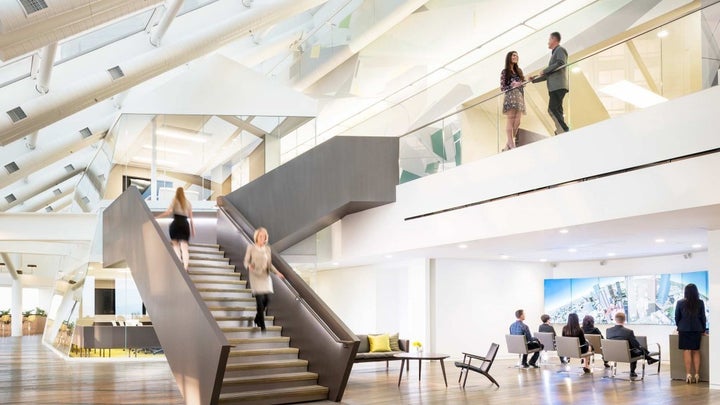
CBRE Headquarters, Los Angeles, Architect: Gensler
There is a growing volume of research that demonstrates the value in building strategies that contribute to healthier employees. Workplace wellness programmes now represent a $6 billion-a-year industry, yet usually they don’t incorporate the work environment which impacts not only our physical health, but also our mental state and emotions. Our spaces need to support tasks at hand, reinforce company brand and values, and facilitate healthier behaviors.
Long hours sitting at a desk is common workplace behavior. According to Professor Sean Mackey MD of the Stanford University Medical Center, lower back pain affects more than 100 million Americans, and its incidence is increasing in all age groups. It is considered the №2 reason for disability (the common cold is №1)and just part of the problem, as employees also run the risk of repetitive stress injuries as well as stress related mental illness, all costing billions of dollars to the economy.
So let’s start with the basics:
Ergonomics and Active Design
Provide your employees with comfortable, ergonomically correct seating and worktables. People come in all shapes and sizes. This makes it more challenging to find the right ergonomic seating arrangement for each individual.
Adjustable chairs have been an accepted part of office design for many years, but staying seated for prolonged periods of time can increase the risk for heart disease, diabetes and cancer – regardless of whether the person exercises regularly are not. Even exercising an hour or more a day doesn’t eliminate the health risk that comes from regular prolonged sitting. More and more health professionals describe this phenomenon as “Sitting is the new Smoking” so encouraging movement throughout the day is essential. Electrically-operated tables and computer workstations that can be height adjusted at the touch of a button are becoming standard equipment in modern offices. These “Sit-to-Stand” workstations allow employees to change their seating position throughout the day, moving from a seated position to a standing position at the touch of a button.
Make sure your employees have choices of places to work to encourage them to be more active and move away from their desk throughout the day, to undertake variable tasks; concentrate, collaborate, recharge and focus.
Create a variety of spaces for teams and departments so employees can work alone or collaborate, according to their changing needs and personal preferences. Neighborhoods can be allocated to teams so that they work both as knowledge-sharing and social spaces, with a combination of individual workstations, collaborative spaces and quiet spaces to focus.
Finally, introduce well designed and convenient interconnecting stairs to minimize use of lifts and facilitate more activity, as well as on site exercise and relaxation amenities to help people, recharge throughout the day.
Light & Air
Natural light has a major effect on employee engagement and productivity. If you are relying on artificial light, be cautious and aware of what type of light. Millions of iPhone users have suffered the unintended effects that artificial lighting has on our physiology — such as when we try to stay awake or go to sleep. Apple’s recently introduced Night Shift feature changes the screen to a warmer colour palette during the late-night hours to help promote sleep.
The World Green Building Council reports that being close to daylight results in more optimal sleep and productivity of focused work increased by 15% for workers close to a widow, whilst better air quality can result in an 8–11% productivity increase and double cognitive ability. So when you are considering how to organize your office space layout, try to maximize natural light streaming into the workspace and ensure that artificial light incorporates dynamic circadian lighting that changes throughout the day to support healthy sleep and effective working.
Don’t overlook other environmental cues that improve employee productivity such as invisible toxins inside offices that can have a profound impact on how our bodies function. Reducing toxins within the built environment requires a multi-faceted approach. Companies should consider sustainable materials specification during building design. Sourcing furniture, fixtures and fittings, including paint, with low levels of contaminants called volatile organic compounds (VOCs) can also help reduce toxicity. Consideration should also be given to air filtration standards, proper ventilation and operational policies such as green cleaning, each of which can also have an impact.
Nature
Increasingly, studies are demonstrating that greater connection with nature decreases stress and enhances mental wellbeing. Companies can achieve biophilic design- design that reflects the natural world- by integrating patterns, colors and materials found in nature or by incorporating natural features. Incorporating plants in the workplace, is an effective way to reduce toxins and increase productivity. In an 18 month project, Dr. Craig Knight from Exeter University, demonstrated that adding houseplants to an otherwise sparse office environment, can increase well-being by 47%, increase creativity by 45% and increase productivity by 38%.
Policies
Wellness goes beyond the built environment and depends on an integrated understanding of all that impacts health in the workplace. Job demand, management style and level of autonomy can all influence wellbeing, as can availability of healthy food and accessible drinking water. Companies wanting to promote wellness, need to commit to aligning organisational policies across operational silos, prioritize desired outcomes and commit to a comprehensive change management process.
Metrics
The question quickly arises, how to measure “wellness”: what can be tracked, and how can performance be bench-marked?
Use data to drive a change management approach- changing behaviors has far more impact than just changing space. Data gives organisations the power to initiate change, communicate and market business improvements.
Leverage new building rating and bench-marking tools that provide cross disciplinary metrics. Dovetailing neatly with existing green building rating tools, The WELL Building Standard translates seven years’ research across both the medical and built-environment professions, into a range of evidence-based design criteria, operational performance requirements and organisational procedures to support human health and wellness. It measures seven factors that impact occupant health: air, water, nourishment, light, fitness, comfort and mind.
An early pilot project, the CBRE Headquarters in L.A., found 83% of staff were more productive in their new WELL-Certified space, with 92% also reporting a positive effect on their health and wellbeing.

As we strive towards designing for overall occupant experience in the workplace, we will see more and more new, interdisciplinary teams mobilizing to successfully address both physical and non-physical aspects of work. At a strategic level, organizations should start embedding wellness principles and approaches into building development briefs, fit-out guides and operational policies, as well as the formulation of long-sighted workplace strategies that fundamentally unite HR, CRE, business and people.
This was originally published in Thrive Global January, 25, 2017
